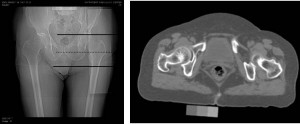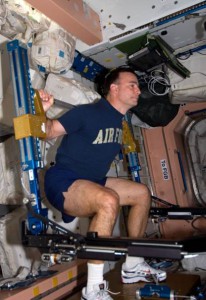In today’s A Lab Aloft entry, International Space Station Program Scientist Julie Robinson, Ph.D., continues her countdown of the top ten research results from the space station, recently presented at the International Astronautical Conference in Beijing, China. Be sure to check back for daily postings of the entire listing.
This topic of research is the culmination of years of study, starting with the very first International Space Station flight investigation into the loss of bone by astronauts. During the first part of space station history, astronauts were losing about one and a half percent of their total bone mass density per month. That’s a rate similar to a post-menopausal woman’s bone loss for an entire year—which is really significant.

Early space station researchers first identified this loss rate. Then they found that the exercises we were having the crew perform were not really providing the right forces to counter the bone mass reduction. Scientists started looking at crew member diet and exercise routines, along with the addition of upgraded exercise hardware. This progression culminated in the September 2012 publication in the Journal of Bone and Mineral Research.
Scientists found that the correct mixture of set durations of high-intensity resistive exercise, combined with the right amount of dietary supplementation for vitamin D and specific caloric intake were key for bone health. With all of these things together, the astronauts could return to Earth after living in space without having lost significant bone mass. This is just one solution; there may be others. But this is a viable answer to an issue identified clear back during the Gemini missions, addressing a huge problem when humans go into space and lose gravity loading on their bodies.

With this research, we can better understand how bone changes throughout life, in growth and aging, and how to prevent outcomes such as age-related bone fractures. This topic received an award at this year’s International Space Station Research and Development Conference, recognizing the community of NASA and academic scientists for carrying out research to define the extent and characteristics of bone loss in spaceflight, and for developing exercise- and drug-based approaches to attack the problem. Thomas Lang, Ph.D., professor of Radiology and Biomedical Imaging at the University of California San Francisco, was the recipient of the team award in recognition of outstanding results on preventing bone loss in long-duration spaceflight.
This is important of course for future exploration by astronauts, but also for patients on the ground. The paper made the cover of the Journal of Bone and Mineral Research, due to the fact that it provides a very different way of looking at bone loss from what is typical in the osteoporosis research community.
When most women are diagnosed with osteoporosis, the next thing their doctor will tell them is: “Well, stay active, go walking, but don’t do anything too rigorous.” We found that by doing rigorous exercise, however, astronauts that don’t have other kinds of health issues were able to protect their bone. It’s going to take some time for the medical community to absorb how these results with astronauts might be applicable to others, especially those on the ground. This is a compelling result for the whole world, because it gives us insights into how bone is formed and maintained in the human body that could not have been obtained any other way.
Julie A. Robinson, Ph.D.
International Space Station Program Scientist

This is highly interesting and educational. I like it keep up the great work!